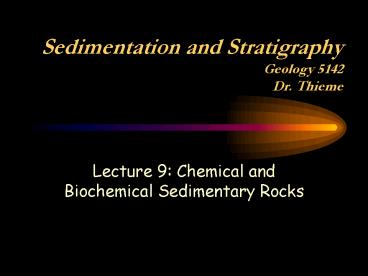Sedimentation and Stratigraphy Geology 5142 Dr' Thieme PowerPoint PPT Presentation
1 / 20
Title: Sedimentation and Stratigraphy Geology 5142 Dr' Thieme
1
Sedimentation and StratigraphyGeology 5142Dr.
Thieme
- Lecture 9 Chemical and Biochemical Sedimentary
Rocks
2
Carbonates
- account for approximately 1/10th of the rocks
exposed at the Earth's surface - Lithologies include
- limestone
- oolite
- coquina
- travertine
- marl
- chalk
- dolostone
- marble
3
Carbonates
- the principal rock-forming carbonate minerals
are - Calcite - CaCO3
- some substitution of Mg
- hence "high Magnesium" and "low Magnesium"
calcite - Aragonite - a "polymorph" (CaCO3)
- Dolomite - MgCaCO3
- might also see Siderite (FeCO3) , Magnesite
(MgCO3), Rhodocrosite (MnCO3). Ankerite - Ca
(Fe,Mg,Mn)(CO3)2
4
Calcite Compensation Depth (CCD)
5
Adjectives for Field Use
- Dolomitic - has the mineral dolomite in it
- Calcareous - has the mineral calcite in it (not
used with limestone) - Argillaceous - has clay present in it.
- Arenaceous - has sand size detrital grains
- Fossiliferous - "skeletal" material of animals
and plants - Oolitic - contains oolites (ooids)
- Pisolitic - contains pisolites (pisoids)
- Peloidal contains peloids
- Cherty - contains chert nodules
- Brecciated - the rock is broken in situ
6
Dunham Classification
- can be used with hand samples
- mirrors the Pettijohn classification of
siliciclastic sedimentary rocks into mudstone,
wacke, and arenite
7
Use of the Dunham classification makes it
possible to use a common scale on a graphic log
to illustrate both the carbonate rocks and the
siliciclastic rocks
8
Chemical Rock Components
- Folk (1959, 1962) separated
- Allochems ("from outside") - carbonate grains
transported and deposited as clasts - Orthochems ("true") found where they formed
- micrite is fine-grained carbonate mud, the
matrix in a "wackestone" - spar is cement identifiable as clear
interlocking crystals that "sparkle"
9
Folk classification
10
Allochems (Skeletal grains)
11
Mollusc (Bivalves, Pelecypods)
A mollusc shell in the Castle Hayne ls
A mollusc shell replaced by spar calcite
12
Brachiopods
Brachiopod shells form as calcite so the internal
structure preserves and they look very different
from mollusc shells (wavy or oblique layers
of calcite)
13
Echinoderms
Echinoderms also make calcite, but only for a few
body parts, particularly the plates on the
outside of crinoids, sea urchins, and their
relatives.
14
Ooids and Peloids
15
Biolithite
16
Biomicrite
17
Biomicrudite
18
Biosparite
19
Pelsparite
20
Biopelsparite

